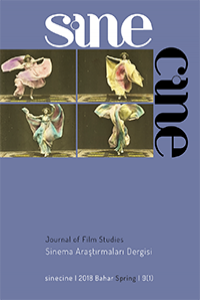Öz
Cinema has been concerned with history from its earlier days. Historical events and people have become popular subjects for film directors. The inclusion of historical representations in cinema has been of interest to academic historians over time and some have collaborated with filmmakers in various ways, such as consulting for authenticity, being expert guests in documentaries, writing academic film reviews, and conducting related research. This dialogue between historians and cinematographers generated the questions “What is a historical film?”, “What is the relationship or difference between written history and cinematic history?”, and “If written history is not a mirror but a construction, then what is the relation between reality and filmed history?” Just as it is possible to divide written history into a number of categories, filmed history can be seen as “history as drama,” “history as anti-drama,” “unheroic history,” “history as an exhibition,” “history as an article,” “oral history,” “post-modern history,” and so on. However, in this article, historical representations in cinema are reduced to three broad categories, “history as drama,” “history as a document,” and “history as an experiment.” “History as drama” is created in the film by dramatization of real or fictional characters in historical settings. “History as a document” is the representation of various films, photographs, works, tables, graphics, newspa-per and magazine clippings on screen in the presence of narrators, witnesses, or experts. “History as an experiment” is a combination of both, embodying both dramatic and documentary characteristics. In each of these three categories, history is reshaped by cinematographic methods, techniques, and aesthetic decisions, and historical reality undergoes a cinematic reconstruction.
Anahtar Kelimeler
Cinema history historical film historical representation history as drama history as document history as experiment
Kaynakça
- Davis, N. Z. (1983), The Return of Martin Guerre, Cambridge, Mass., s. viii.
- Davis, N. Z. (1987). Any Resemblance to Persons Living or Dead’: Film and the Challenge of Authenticity, Yale Review, No. 76, September, pp. 457-82.
- O’ Connor, J. E., Jackson, M. A. (1979). American History/American Film: Interpreting the Hollywood Image (eds.), New York. The ‘Glory’ Story. (1990). New Republic, No; 202, January 8, pp. 22- 27.
- Walkowitz, D. J. (1985). Visual History: The Craft of the Historian- Filmmaker, Public Historian, No.7, Winter, s. 57.
- White, H. (1988). Historiography and Historiophoty. The American Historical Review, Volume 93, Issue 5, 1 December, pp. 1193.
Öz
Sinema daha ilk günlerinden itibaren birçok alanla olduğu gibi tarihle de ilgilenmeye başlamış, tarihsel olay ve kişiler yönetmenlerin en popüler konularından biri olmuştur. Sinemada tarihsel temsillere yer verilmesi zaman içinde akademik tarihçilerin de ilgisini çekmiş ve bu durum tarihçileri, danışmanlık, belgesellerde uzman konuk olma ya da akademik film incelemeleri yapma gibi çeşitli biçimlerde sinemacılarla iş birliği yapmaya ya da bu alanda eserler vermeye yöneltmiştir. Tarihçiler ve sinemacılar arasında kurulan bu iletişim “Tarihsel film nedir?”, “Yazılı tarih ile sinemasal tarih arasında nasıl bir ilişki ya da ne gibi bir fark vardır?” ve “Yazılı tarihi bir ayna değil de bir inşa kabul edersek, filmdeki tarihin gerçeklikle ilişkisi nedir?” sorularını doğurmuştur. Nasıl ki yazılı tarihi birtakım kategorilere ayırmak mümkün ise “filmdeki tarihi” de “drama olarak tarih”, “antidrama olarak tarih”, “kahramansız tarih”, “gösteri olarak tarih”, “ma-kale olarak tarih”, “kişisel tarih”, “sözlü tarih”, “postmodern tarih” gibi birtakım kategorilere ayırmak mümkündür. Ancak bu makalede sinemadaki tarih temsilleri, “drama olarak tarih”, “belge olarak tarih” ve “deney olarak tarih” olmak üzere üç geniş kategoriye indirgenmektedir. “Drama olarak tarih”, filmde gerçek ya da kurgusal karakterlerin tarihi ortamda dramatize edilmesiyle oluşturulur. “Belge olarak tarih” ise çeşitli filmler, fotoğraflar, eserler, tablolar, grafikler, gazete ve dergi kupürlerinin anlatıcı, tanıklar veya uzmanlar eşliğinde beyazperdede sunulmasıdır. “Deney olarak tarih” ise hem dramatik hem de belgesel özellikleri gösteren, ikisinin bir kombinasyonudur. Tabii bu üç kategoride de tarih, sinemanın anlatım yöntemleri, teknikleri ve estetik olanaklarıyla yeniden şekillenmekte ve tarihsel gerçeklik bu defa da sinemasal bir yeniden inşaya uğramaktadır.
Anahtar Kelimeler
Sinema tarih tarihsel film tarihsel temsil drama olarak ta- rih belge olarak tarih deney olarak tarih
Kaynakça
- Davis, N. Z. (1983), The Return of Martin Guerre, Cambridge, Mass., s. viii.
- Davis, N. Z. (1987). Any Resemblance to Persons Living or Dead’: Film and the Challenge of Authenticity, Yale Review, No. 76, September, pp. 457-82.
- O’ Connor, J. E., Jackson, M. A. (1979). American History/American Film: Interpreting the Hollywood Image (eds.), New York. The ‘Glory’ Story. (1990). New Republic, No; 202, January 8, pp. 22- 27.
- Walkowitz, D. J. (1985). Visual History: The Craft of the Historian- Filmmaker, Public Historian, No.7, Winter, s. 57.
- White, H. (1988). Historiography and Historiophoty. The American Historical Review, Volume 93, Issue 5, 1 December, pp. 1193.
Ayrıntılar
| Birincil Dil | İngilizce |
|---|---|
| Bölüm | Çeviri |
| Yazarlar | |
| Yayımlanma Tarihi | 11 Mayıs 2018 |
| Yayımlandığı Sayı | Yıl 2018 Cilt: 9 Sayı: 1 |
sinecine TR DİZİN ve FIAF tarafından taranmaktadır.


